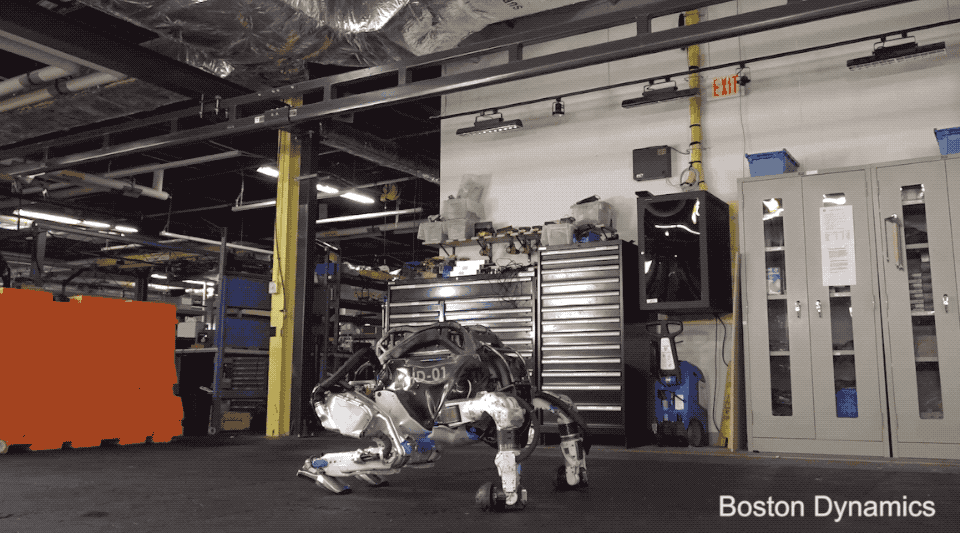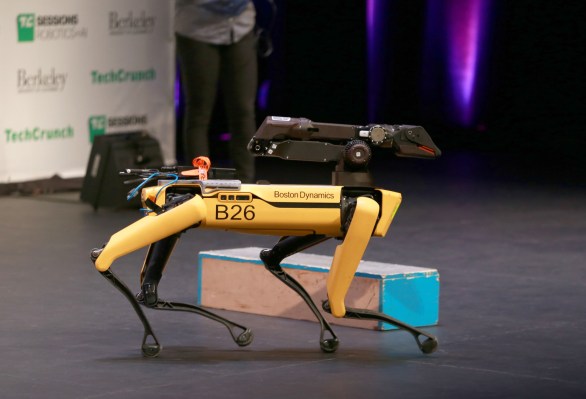After more than a quarter-century spent developing some of the industry’s most iconic and advanced machines, Boston Dynamics is a company in the midst of a profound transformation. This week, the Waltham, Mass.-based organization issued a number of key announcements, all focused on the same fundamental shift, as it readies the release of two commercial robots: Spot and Handle.
The top of the company has recently seen its first major shakeup since its founding in the early 1990s. Founder Marc Raibert has stepped aside from his role as CEO, a transition that occurred quietly back in October. Longtime employee Rob Playter will be stepping into the position, having most recently served as Boston Dynamics’ COO.
Playter joined the company early on, after penning a PhD thesis on “Passive Dynamics in the Control of Gymnastic Maneuvers.” A former NCAA gymnast himself, Playter’s work clearly has a bit of a spiritual successor in the complex maneuvers of the bipedal Atlas — arguably the most advanced of Boston Dynamics’ machines.
The move comes during an important crossroads for the company, and Raibert, its longtime leader, public face and chief evangelist. “I just had my 70th birthday,” he tells TechCrunch. “So I’ve been thinking about this for about a year that we needed a succession plan and I had been working on it during that time, talking to SoftBank, making sure they were cool with the idea, and making sure I was cool with the idea.”
Playter has hung with the company through numerous changes, serving as a Robotics Director at Google after the software giant purchased Boston Dynamics back in 2013. When the company switched hands to SoftBank, he took on the COO role.

“I’ve been the organizational guy for a long time,” he says. “I basically hired most of the people in the company and growing us aggressively is a big challenge right now. Over the past year, bringing on new people into our executive leadership team has been a primary goal, as well as feeding an insatiable appetite for our technical teams to grow in order to meet the goals we’ve set for them. Which includes not only advancing the state of the art of robotics but actually making some of our robots into products and delivering them and supporting them and changing the organization to do so.”
Focus for many at Boston Dynamics has shifted in recent years. At our Robotics event a few years back, Raibert announced plans to offer a commercial version of its Spot robot, aimed at performing security, construction site inspections and a variety of different tasks. Spot officially went on sale in September, and the company tells TechCrunch that it’s ramping up production with hopes of hitting 1,000 a year.
Boston Dynamics has long insisted that the production version of Spot will be a platform, allowing end users to tailor it to a variety of different tasks. That dream takes a step closer to reality with the release of the Spot software development kit on GitHub this week.
“The SDK enables a broad range of developers and non-traditional roboticists to communicate with the robot and develop custom applications that enable Spot to do useful tasks across a wide range of industries,” VP Michael Perry said in a statement offered to TechCrunch. “With the SDK, developers in the Early Adopter Program can create custom methods of controlling the robot, integrate sensor information into data analysis tools, and design custom payloads which expand the capabilities of the base robot platform.”
The company has already announced a few early partners. Perry again, “One of our [partners], HoloBuilder, is using the SDK to integrate Spot into their existing app. With what they’ve developed, workers can use a phone to teach Spot to document a path around a construction site and then Spot will autonomously navigate that path and take 360 images that go right into their processing software. Other customers are exploring VR control, automated registration of laser-scanning, connecting Spot’s data to cloud work order services, using Edge computing to help Spot semantically understand its environment, and much more.”
In keeping with the company’s longstanding viral approach to marketing, buster of myths Adam Savage is among the early developers. Savage will participate in development with the robot for the next year, a milestone he celebrated with the release of a Tested video that understandably mostly entails him controlling the robot like a kid with a new RC car on Christmas morning.
Ultimately, Boston Dynamics will only have so much input into what happens to these robots once they’re out in the world. There are currently nearly 100 robots out in the world, and production is ramping up to around 83 units a month. A video that debuted onstage at our robotics event last year recently caused a dust up with the ACLU after showcasing state police using Spot in hostage rescue field training.
“There is a part of a humanity that loves to worry about robots taking over or being weaponized or something like that,” says Raibert. “We definitely want to counter that narrative. We’re not interested in weaponized robots. We’ve also gotten positive feedback from the fact that the police were using our robot to look at suspicious packages. There’s a real safety issue there and that it generated some additional interest with us as well. I mean, this isn’t really anything different than any new technology. There’s a wide variety of things it can be used for. We’re working to be responsible and trying find the good things that it could be used for.”
SoftBank’s 2018 acquisition marked a major turning point for the company, of course. Though Boston Dynamics insists that the investor firm has done little in the way of pressing it into commercialization. Those plans, it explains, were already in the works.
“I think the remarkable thing about SoftBank is they’re absolutely interested in the products and the moneymaking potential of what we’re doing while having a very serious interest in support for the longer range stuff we’re doing,” says Raibert, who is staying on at BD/SoftBank in a chairman role. “And over the 18 months that we’ve been part of SoftBank, I’ve repeatedly tested that commitment. Talking to the top leadership at SoftBank and they have repeatedly endorsed that. They’re very enthusiastic also for us to productize and make robots and make robot products.”
The company will maintain its commitment to developing research robots, a role Raibert will continue to help facilitate. That list includes products like Atlas and, no doubt, some still unannounced products. Others, including Handle, will be developed with an eye toward production. In April, the company acquired Bay Area-based 3D vision startup Kinema Systems to bring imaging to the pick-and-place robot.
Boston Dynamics tells TechCrunch that it plans to offer the robot up for commercial use in the next two years.
“We’ve been doing proof of concept tests with Handle and some early customers to validate our expectations on what the useful tasks are in a warehouse for moving boxes around,” says Playter. “We have a small set of those customers and we’re getting feedback from them. So far they’re really excited about this capability. It’s unique. As far as I know, we’re the only case-picking warehouse robot in development right now. And this is just a ubiquitous job, whether you’re unloading trucks or loading trucks or building pallets or de-palletizing. There’s thousands of warehouses just full of boxes.”
